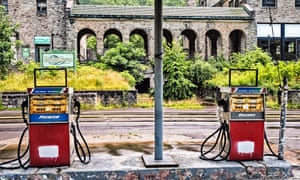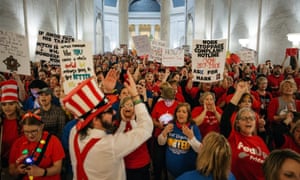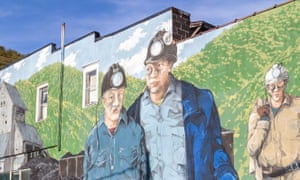Appalachia wasn’t always conservative. In Virginia’s coal country, a
long history of grassroots organising is inspiring a new wave of
activism. By
Elizabeth Catte
When
my grandfather was a child, his stepfather would bring him along as he
sold moonshine to poor working men in south-west Virginia coal country.
The men adored my grandfather, who was not yet even school age, for his
talent for mocking Democrats.
He told me this story on a few occasions to explain, I think, the
inevitability of his later affiliation with the Republican party. He was
a Republican in much the same way that I am a Democrat – voting with
little enthusiasm every few years and sometimes not at all.
When I consider that story now, I find myself thinking less
about my grandfather and more about the men who laughed at his jokes.
What were their politics? Not all were the predecessors of today’s Republicans,
as we might imagine them to be. In Appalachia, so-called “mountain
Republicans” comprised an old vanguard of anti-secessionists, who
opposed slavery and the Confederacy. They saw themselves as heirs to the
enlightened legacy of Abraham Lincoln, the first Republican president.
My grandfather belonged (or at least aspired to belong) to that
tradition. His audience might have consisted of Democrats, who enjoyed
hearing their abuses repeated in the mouth of a child. But it is more
likely that they would describe themselves as without politics, just
laughing at the powerful and self-important. For a long time, it did not
occur to me there were other possibilities.My wider view of politics in Virginia’s coal country changed when I discovered that the publisher of my grandfather’s local community paper, Crawford’s Weekly, was a communist. And not just a communist in print, but a shot-while-inciting-class-war, sabotage-the-New-Deal-from-within, run-for-local-political-office-on-a-platform-of-a-producer’s-republic communist. His name was Bruce Crawford, and when my partner, also from south-west Virginia, discovered his writings, we read them aloud to each other as though they were letters from an eccentric uncle.
Rural spaces are often thought of as places absent of things, from people of colour to modern amenities to radical politics. The truth, as usual, is more complicated. The parents and grandparents of my childhood friends were union organisers; when my grandfather moved to east Tennessee, he went from a world of communist coal miners to the backyard of one of the most important incubators of the civil rights movement, the Highlander Research and Education Center. I now organise with people whose families have fought against economic exploitation for generations. From my vantage point in West Virginia and south-west Virginia, what is old is new again: the revival of a labour movement, the fight against extractive capitalism, the struggle against corporate money in politics and the continuation of women’s grassroots leadership.
Appalachia has become symbolic of the forces that gave us Donald Trump. After all, his pandering to white racial anxiety did find purchase here. His fantasies to make America great again centre on our dying coal industry. And the region’s conservative voters, who have been profiled endlessly, have been a reliable stand-in for all Trump voters, absorbing the outrage of progressive readers. But what Pelosi and Israel see as common sense and pragmatism can also be interpreted as tired oversimplifications and a failure of imagination.
We remain attached, after all, to narratives that have worked very hard to simplify and neatly divide the state of the union: blue cities, red rural areas, a few swing suburbs. “In a period of political tumult, we grasp for quick certainties,” wrote the sociologist Arlie Russell Hochschild in Strangers in Their Own Land (2016). Indeed, the biggest gift that the left has given the right since 2016 is not a few avowed socialists but the myth that Trump voters are inscrutable and monolithic. “I love Cleveland, but I’ve always considered it separate from Ohio,” resident Julie Goulis told the Guardian just before the 2017 inauguration. “Some of the soul-searching I’ve been doing after the election has been about how I can understand people outside of my bubble.”
It would be far better for progressives to save their bubble-popping for moments such as this, when an opportunity emerges to better understand those closer on the political spectrum in those same spaces. The limbo we are trapped in compels white progressives to attempt to understand Trump voters rather than rural socialists or communists – or even rural people of colour, who face many of the same struggles as Trump voters, perhaps even more pronounced, and choose a different way forward.
Let us get free of that, once and for all. Appalachia should not be seen as a liability to the left, a place that time and progress forgot. The past itself is not a negative asset. The hierarchies and systems of power here feel old because they are, but this legacy also means there are many who are well practiced in the art of survival and resistance. Our present can be reckoned with, and a different future emerge, but the way forward for the left, in my world, is through the past.
When Ocasio-Cortez asks if voters are prepared to choose people over money, I hear echoes of a much older question that still resonates in Appalachia: which side are you on? In 1931, when Black Mountain Coal Company cut miners’ wages in Harlan, Kentucky, a long strike ensued. Harlan’s infamously corrupt sheriff, JH Blair, terrorised union families; law enforcement, including the National Guard, intervened on behalf of the interests of coal operators to force miners – through threats, coercion and violence – to return to work. When the sheriff and deputised coal company operatives ransacked activist Florence Reece’s home in search of her husband, who helped organise the strike, Reece penned what would become one of history’s most recognisable labour anthems, Which Side Are You On? The song galvanised workers and inspired bystanders to surrender the illusion that one could be impartial in the face of so much oppression. “Us poor folks haven’t got a chance unless we organise,” she sang. “They say in Harlan County there are no neutrals there.”

In late 2016, for example, a young man named Nic Smith, another product of south-west Virginia, made headlines for his participation in a #Fightfor15 demonstration. Outside a Richmond McDonald’s, Smith, a Waffle House employee, connected the plight of fast-food workers with the past struggles of coal miners in his family. He also pushed back against the Trumpian reactionary politics that elevates white working-class racial anxiety over class solidarity. “Ain’t no damn immigrant stole a coal job,” Smith said. “I’ll tell you that right now. And really, even if they did, would you really be blaming the immigrants or the people that hired them? The only reason they would hire an immigrant over an American citizen is if it benefits their wallets.”
Instead of rigging a dying industry, Smith explains in a Washington Post op-ed, it would be far better to unionise low-wage workers and raise the minimum wage. He joined #Fightfor15, he wrote, because his family “has always understood that we can’t wait for a saviour at the ballot box to shepherd in the change we so desperately need”.
A self-described “damn white trash hillbilly from the holler”, Smith is an exotic figure to the many media outlets that covered him. Vice complimented him for not fitting “the image of the typical millennial activist” – a former factory worker, you see, who “isn’t the kind of Democratic socialist who spouts off at Brooklyn parties about the ‘means of production’”. Smith’s approach is fairly typical, however, if you are looking from Appalachia rather than New York. Here, activists such as Smith often connect to the struggles of their parents and grandparents as they engage in activism.
Brandon Wolford, for example, a teacher from Mingo County, West Virginia, grew up watching news footage of 1980s miners’ strikes that his father participated in. The price of coal had declined, and companies such as the Pittston Coal Company tried to recoup their losses by slashing workers’ wages and benefits. In the case of Pittston, the United Mine Workers of America eventually prevailed, winning back many protections and securing others, although coal’s economic slump made it difficult for organised labour to rebound fully. The memories of those and other labour victories, however, stayed with families. “Knowing the role my father and both grandfathers had played in these events sparked a special interest,” Wolford wrote in 55 Strong: Inside the West Virginia Teachers’ Strike, in 2018. “I wanted to be involved in a movement like that someday.”
In February 2018, Wolford joined more than 20,000 West Virginia teachers and public school employees who went on strike to force state leaders to reckon with inflated insurance premiums, low pay and a widespread teacher shortage. The strike closed schools in all 55 counties for nine days and endured even after union support stopped. It ended with a 5% pay raise across the board and a pledge from state leaders to re-examine the state’s public employee insurance agency.
The West Virginia teachers’ strike emerged as one of the clearest visions of the new labour movement. It inspired education strikes in other states, including Kentucky and North Carolina. But understanding the strike requires knowing a century of southern West Virginia history, notably its infamous labour uprisings, from the Mine Wars of the 1920s to big coal’s union-busting campaigns of the 1980s. When momentum to strike built in early 2018, teachers in West Virginia’s coal country were among the first to mobilise and put action to a vote. In a Facebook group, they used coal country’s labour history to portray the strike as not only urgent and just, but also natural – something that people like them had been doing for generations. In a speech at a countywide meeting, Katie Endicott, an English teacher from Mingo County, emphasised the familiarity: “If we can do this, if we can stand, then we know that our brothers and sisters in Wyoming [County] are not going to let us stand alone. We know that our brothers and sisters in Logan County will not let us stand alone. The south will stand. And if the south stands, the rest of the state will follow our lead.”
To create solidarity in the present, to make change for the future, West Virginians needed to remember their radical past. To the extent that collective action requires a public narrative – a story that helps consolidate its moving parts and moral purpose – West Virginia’s south played its part exceptionally.
This past sits uneasily within Joe Manchin’s vision of West Virginia. In the aftermath of the 2016 presidential election, Manchin, the state’s former governor and second-term Democratic senator, became a favourite of pundits. They predicted that Democrats’ only lifeline would be replicating his limp style of centrist politics. An Atlantic essay titled What Joe Manchin Can Teach Democrats touted Manchin’s utility as “a sounding board for, and bridge between, his party’s leadership and conservative, rural, white voters”. Manchin’s vote to confirm Brett Kavanaugh to the supreme court amid allegations of sexual assault did little to dim pundits’ rose-coloured view of the great moderate. Manchin was better than no Democrat at all, they reasoned – the best West Virginia can do.

Yet as writer Aaron Bady, a West Virginia native, counters: “It’s because I am burdened with a handful of facts about West Virginia – and a memory that goes back more than two years – that this kind of analysis stands out as the garbage that it is.” One of these facts is the 1996 gubernatorial race, in which Manchin was outflanked on the left in the Democratic primary by Charlotte Pritt. Pritt’s anti-corporate platform alienated coal industry power players; Manchin, a coal millionaire, convinced a coalition of Democrats to finance and support Pritt’s Republican challenger, Cecil Underwood. For many observers, Manchin’s vengeance went beyond politics: Pritt was a teacher and the daughter of a coal miner, you see; she was a worker and she beat an owner. The 1996 election and Manchin’s later political ascent prove less about the left’s potential in West Virginia than they reflect a common truth: bosses cheat to win.
His logic is simple: West Virginia’s workers, whether coal miners or teachers, have never benefited from the state’s natural wealth due to greedy corporations and the politicians they buy. Ojeda’s plainspoken, often angry distillations of the state’s woes, and his tender attention to the plight of teachers, grabbed national attention. He was featured as an example of someone who could turn the tide for Democrats in “Middle American places where their party used to prevail, but has been decimated in the Trump era,” as journalist Trip Gabriel suggests.
Ojeda’s willingness to stoke rather than soothe the growing militancy of West Virginia’s rank and file undermines the claim that the state is doomed to centrist Democrats. His success should not be underestimated. But, like Manchin and current governor Jim Justice (a lifelong Republican who got elected as a Democrat only to defect back to the GOP), Ojeda also has a history of straying to the right. Ojeda voted for Trump (a decision he now says he regrets) and has said he might switch teams. Moreover, Ojeda’s evasiveness about the appeal of Trump’s racism among West Virginia voters makes it difficult to embrace him as a unifying leader of the rural left. Indeed, I am reminded of former Republican senator James E Watson’s response to Wendell Willkie when Willkie switched parties, from Democrat to Republican, to run for president in 1940. Asked by Willkie if he believed in the power of conversion, a sceptical Watson replied: “It’s all right if the town whore joins the church, but they don’t let her lead the choir the first night.”
Ojeda’s presidential bid also sends a strong signal that he approves of the media ecosystem that has branded him a novelty. That novelty is dangerous, not least because pundits and political reporters are eager to propagate the idea that to win in places such as West Virginia – and now, it seems, the nation at large – the left needs its own version of Trump: a brash populist, prone to macho posturing, with a no-bullshit persona and little time for the rules or party politics.
But the more Ojeda’s star rises, the further it departs from its grassroots origins, including a labour movement that is 75% women. In a story announcing Ojeda’s presidential bid, for example, the Intercept initially ran a headline that referred to him as the leader of the teachers’ strike – not just a vocal supporter. This mistake, although minor and originating from editors and not Ojeda’s team, is reminiscent of the historical erasure of women’s political work in Appalachia, particularly of women such as Pritt who are further to the left of West Virginia’s Democratic establishment. More recently, there was Paula Jean Swearengin, Manchin’s primary challenger and an environmental activist, and Talley Sergent, who performed just as well as Ojeda in the recent midterms without generating a fraction of his national interest.
The 2016 election still looms over us. But if all you know – or care to know – about Appalachia are election results, then you miss the potential for change. It might feel natural to assume, for example, that the region is doomed to elect conservative leadership. It might seem smart to point at the “D” beside Joe Manchin’s name and think: “It’s better than nothing.” There might be some fleeting concession to political diversity, but in a way that makes it the exception rather than the rule – a spot of blue in Trump Country.
If you believe this, then you might find these examples thin: worthy of individual commendation, but not indicative of the potential for radical change. But where you might look for change, I look for continuity, and it is there that I find the future of the left.

It matters that workers are rising up, and it matters that women are leading. It matters that the fight against extractive capitalism is fiercer than ever. And for all of these actions, it matters that the reasoning is not simply, “this is what is right”, but also, “this is what we do”. That reclamation of identity is powerful. Here, the greatest possible rebuke to the forces that gave us Trump will not be people outside of the region writing sneering columns, and it likely will not start with electoral politics. It will come from ordinary people who turn to their neighbours, relatives, and friends and ask, through their actions: “Which side are you on?”
“Listen to today’s socialists,” the political scientist Corey Robin writes, “and you’ll hear less the language of poverty than of power. Mr Sanders invokes the 1%. Ms Ocasio-Cortez speaks to and for the ‘working class’ – not ‘working people’ or ‘working families’, homey phrases meant to soften and soothe. The 1% and the working class are not economic descriptors. They’re political accusations. They split society in two, declaring one side the illegitimate ruler of the other; one side the taker of the other’s freedom, power and promise.”
This is a language the left knows well in Appalachia and many other rural communities. “The socialist argument against capitalism,” Robin says, “isn’t that it makes us poor. It’s that it makes us unfree.” Indeed, the state motto of West Virginia is montani semper liberi: mountaineers are always free. It was adopted in 1863 to mark West Virginia’s secession from Virginia, a victory that meant these new citizens would not fight a rich man’s war.
There are moments when that freedom feels, to me, unearned. How can one look at our economic conditions and who we have helped elect and claim freedom? But then I imagine the power of people who face their suffering head on and still say: “I am free.” There is no need to visit the future to see the truth in that. There is freedom in fighting old battles because it means that the other side has not won.
This essay is featured in Boston Review’s new print issue: Left Elsewhere: Finding the Future in Radical Rural America

No comments:
Post a Comment